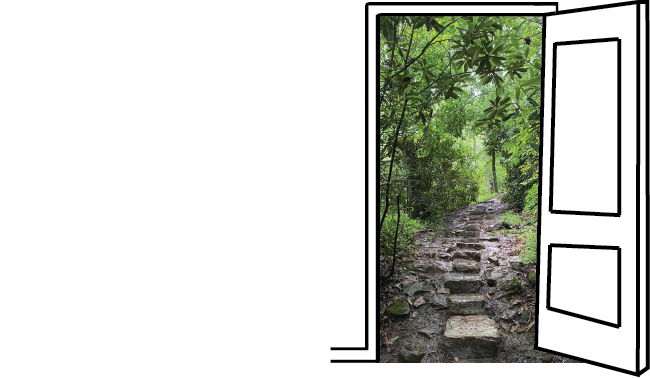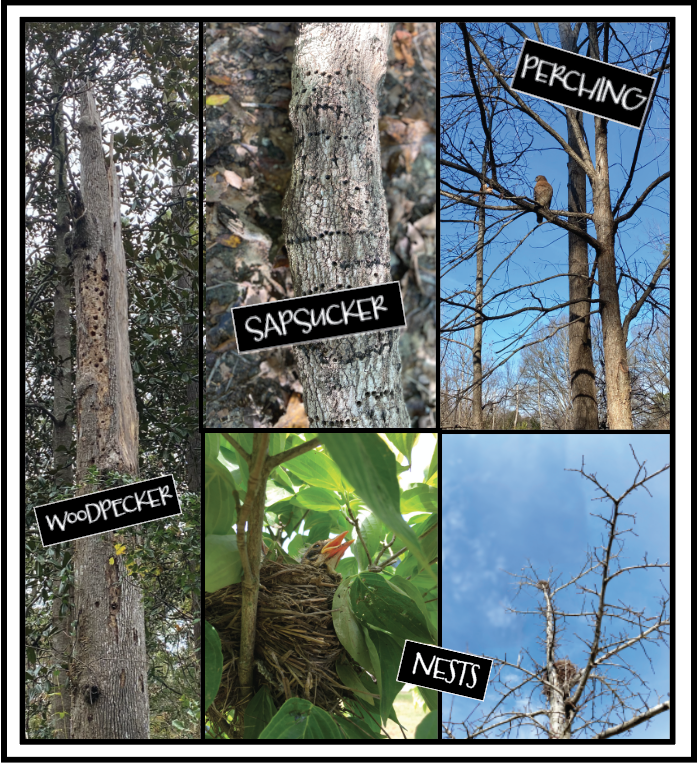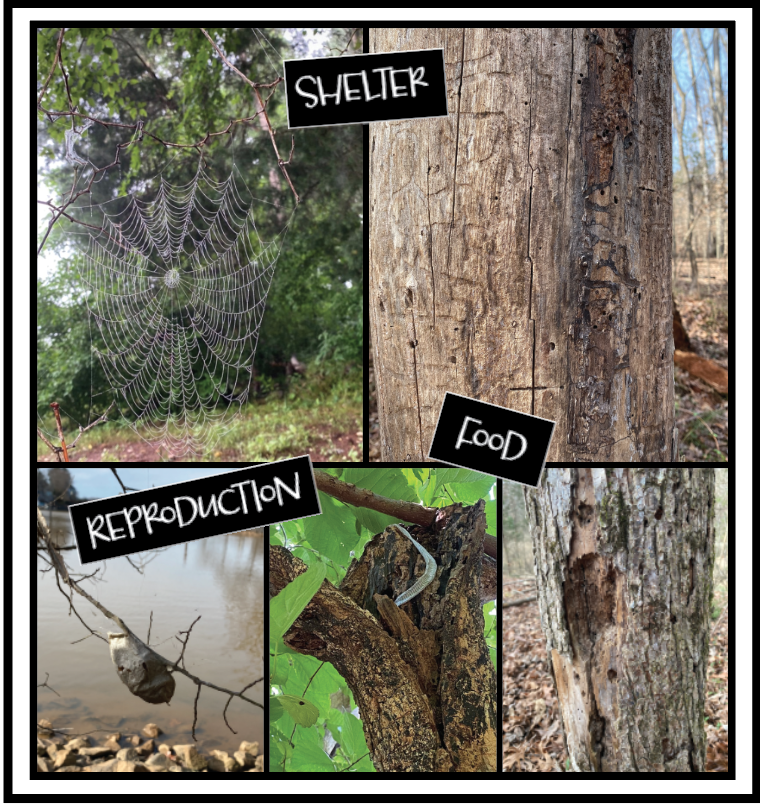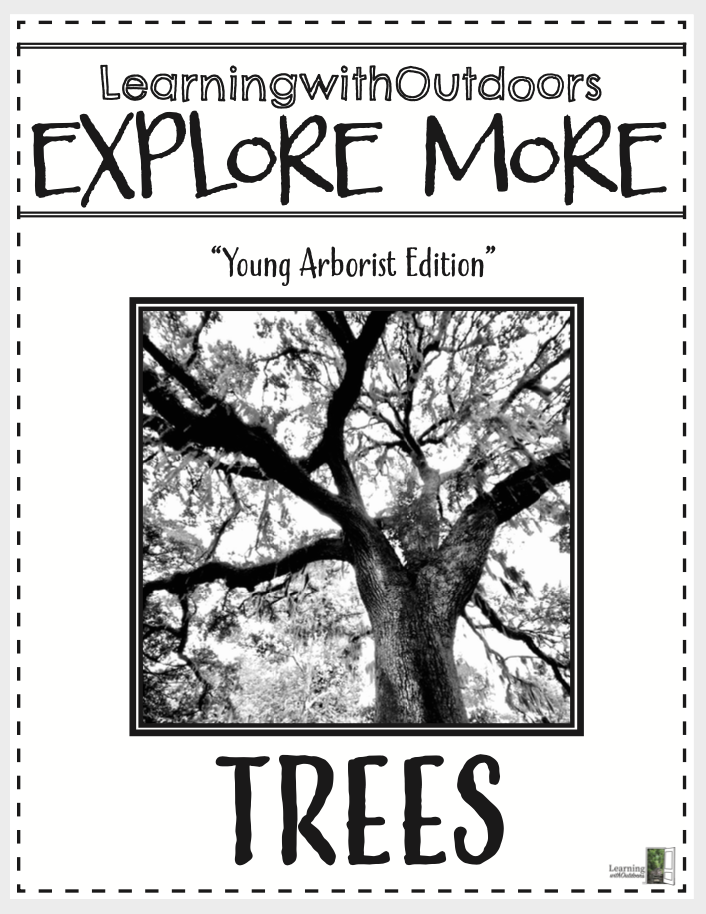Tree Detective: Who used this tree?
We all need trees!
Trees provide us with the air we breathe, the building materials for our homes, the paper we use in a million ways each day and many of the foods we eat. But we are not alone-animals also depend on trees for shelter, food, shade, protection, water and air.
Find out how and then search for evidence yourself!
Trees are critical for a bird's survival!
Shelter- Trees provide the raw materials birds use to build their nests (sticks, leaves) and the protective branches to hold the nest. Some birds nest in holes in the tree, laying their eggs in the nesting cavities to keep their eggs and young safe from predators. Birds use the branches as protection and a spot to rest or roost. Look for evidence: Winter is a wonderful time to spot nests in the branches of trees. Look for nests in low branches and high in the crown of the tree. Think about the size of the nest and try to determine which bird could have built it for its young. Look carefully in cavities for signs a bird might have left behind-twigs, sticks, feathers.
Food- Trees provide food for birds in the form of nuts, berries, seeds, buds, fruit, insects in its bark & leaves and sap. Sapsuckers, like woodpeckers, will drill small shallow holes in neat rows to obtain the delicious sap. This series of holes is called a sapwell. Look for evidence: Search for cracked nuts, branches with missing buds, and a series of small holes in neat rows.
Water- The leaves of the tree collect water after rain and birds often use this as a water source. They also will sometimes bathe by rubbing their feathers against the wet leaves. In winter when many trees have shed their leaves, birds are looking for alternative water sources. Provide a bird bath for the birds in your neighborhood.
Insects & Critters
Some people think of insects and spiders as harmful to trees but they do play an important role in a healthy woodland ecosystem, helping to pollinate trees and replenish soil with nutrients.
Habitat- Many insects, spiders and small critters call a tree home. Have you ever walked on a woodland trail and walked face first into a spider web? If you have, you know that spiders often spin their webs using the branches and twigs of a tree for support, not intending to trap you but rather to collect its next meal. Look for evidence of spiders when you are out hiking. For a fun night search for spiders look here.
Reproduction- Insects also use the protection that a tree offers to reproduce or safely house its young. (ex. The Bark Beetle reproduces between the bark and inner wood of the tree.)
Many moths make their cocoons in the branches of a tree. Moth cocoons are often brown, gray or off-white and are attached to a twig with a silk-like thread. The cocoon is the protective outer layer that covers the Pupa.
Look for evidence of a tree being used to offer protection for a young critter. Winter is a good time to search bare branches for cocoons. You will see an emergent hole if the moth has already emerged from the cocoon.
Food- Insects and other small critters depend on trees for food and the trees in return depend on the insects as well. Did you know that 80% of our trees and bushes are pollinated by insects? Bees, wasps, flies, beetles, ants and butterflies all gather nectar from flowering trees and in turn spread pollen from tree to tree. Many insects also eat leaves and needles as their main food source. During the warm weather months when trees are full of leaves you can see the evidence in the 'munches' taken from the leaves. A wide variety of beetles and other insects are wood borers, meaning they enter the tree through the bark. The Bark Beetle is one you will likely find evidence of. Have you ever seen cool wavy tracks on a piece of wood or tree trunk? That means a bark beetle has been feeding on the bark and wood of the tree. It is interesting to note that although some beetles can be devastating towards a tree population, the bark beetle recognizes sick or weakened trees and bores into those to feed. Look for evidence of bark beetles on fallen trees and trees with exposed wood- & learn how to safely log roll here. (fun way to look for beetle tracks!)
*Snakes also seek the protection a tree offers when they are vulnerable to predators. When snakes are about to shed their skin they often slither up a tree and rub against the branches to help with the shedding process. So many other small critters depend on trees.
Can you think of any others?
Mammals (Non-Humans)
If you are near a lake you might spy a bare spot a couple of feet up from the base of the tree. Beavers use their teeth to gnaw on trees, they eat the wood and also use it to build dams and lodges. Beavers need to keep chewing wood to keep their teeth sharp and also so their teeth don't grow too long.
If you notice long scratch marks on a tree, you may have seen evidence of a bear visiting that tree. These marks will be higher up on the tree as opposed to the low marks made by a beaver. Bears do this for a variety of reasons: to mark their scent, to communicate with other bears, to use the wood scratched off for bedding material, to rub their backs to help shed their winter coats and sometimes to climb the tree for safety.
Other markings you find on a tree might have come from a deer. Male deer, known as bucks, select young trees that are about one to six inches in diameter to mark their territory during breeding season. They also rub their antlers on trees to help them shed off the velvet. If there are deer in the area you are hiking, look closely and you will probably find a deer rub.
You may be wondering who else might live in a hole in a tree besides birds-some mammals do! Flying squirrels and possums use these holes to sleep, reproduce and raise their young. Always use caution when peering into a hole in a tree!
Squirrels are often found running along tree branches, climbing up the trunk of a tree or jumping from tree to tree. They spend a great deal of their time in trees and even nest in the higher branches. Look closely at the top of a tree and you may see a squirrels' drey. This nest or drey is made of dry leaves, twigs and grass and is constructed in the forks of tall trees. Squirrels sleep in the drey and care for their young in them. Be on the lookout for these fun and interesting structures in the top of a tree.
Humans
As mentioned trees provide us with the air we breathe, the building materials for our homes, the paper we use in a million ways each day, many of the foods we eat and shade on hot sunny days. But what do we do for trees in return? Find evidence of human interaction when you are looking at the trees.
Destruction- An example of destruction many people do not even realize IS destruction- is carving initials or names into a big tree. THIS HURTS THE TREE, please don’t hurt trees no matter how badly you want to engrave your forever love or best friend in the forest.
Structures- Humans not only cut down trees for building materials, but you can also find evidence of human interaction on a tree based on the structures added to a tree. (Examples include hammocks, tree houses, and swings) Removable structures on strong sturdy trees should not be harmful to trees or their growth.
Decorations- Another way to find evidence of human interaction with trees is by looking for decorations (like holiday ornaments or pretty lights) or manmade animal habitats/feeders (like bird feeders, squirrel feeders, bug hotels, bat houses etc.)
How do YOU use trees? Hopefully kindly!
Every tree tells us a story, do you ever take the time to learn the story?
Dub each of your children ‘Tree Detectives’ and go on a an animal evidence hunt! Children will work on reasoning skills, problem solving skills, observation skills, science skills, and literacy skills (add in a writing or researching phase!).
Get ready for the release of our very first:
‘Explore More’ Learning Magazine!
Our Learning Magazines are almost entirely black and white for easy printing & can be assembled with one simple staple! Each magazine will be something children can either do on their own, in a small group, or with an adult (parent, teacher, etc.). We do not specify an age recommendation for the learning magazines because the prompts will be open-ended for children to explore at their own developmental level.
So what is in each Learning Magazine?
Spaces for brainstorming and reflection
Academic/creative outdoor learning activity pages (these pages are aids to get children to be hands-on and engaged in nature by guiding them to make observations, record measurements, write thoughts/creative expressions, make plans, and do experiments)
There will be an activity page to help children of all ages be a ‘Tree Detective’ and find out who is using trees near them!
A new curiosity to help spark children’s wonderment and encourage them to be curious about their world
A fun page filled with nature-based games, puzzles, or riddles
A creativity focused page for children to express themselves
“Perfect for: homeschooling, teachers wanting to incorporate more nature into their curriculum, guided self-learning, learning extensions, and curious nature-minded children.”
This first learning magazine is now available in our SHOP !
Subscribe to our emails to never miss a new Learning Magazine Release.





